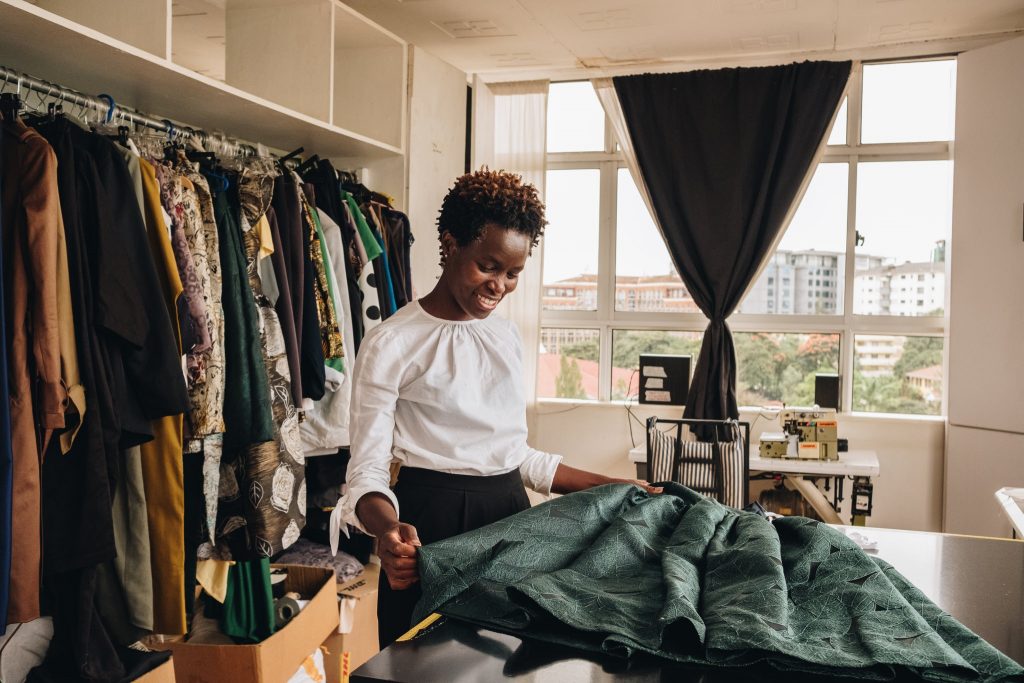Kenya has halted imports of secondhand clothes to prevent the spread of the coronavirus. The move limits fashion selection, but opens doors for the country’s designers and manufacturers.
NAIROBI, Kenya — Catherine Muringo’s wardrobe consists of secondhand outfits shipped from all over the world: colorful blouses and jeans from Canada, floral dresses from the United States, trench coats from Australia and leather handbags from the United Kingdom.
For years, Ms. Muringo bought the used clothes and accessories at cheap prices in open-air markets in Nairobi and used them to fashion her own idiosyncratic style.
Seven years ago, she also started a business buying and selling such items, distributing castoff fur coats, hoodies and shoes to customers in Kenya and in foreign markets like Botswana, Uganda and Tanzania.
But in late March, the Kenyan government banned the importationof used garments in what it said was a precautionary measure to curb the spread of the coronavirus. Even though used clothes are fumigated before being shipped, Kenyan authorities said they were taking precautions because of the spike in infections in countries like the United States.
Now, businesses like hers are threatened, as well as the sartorial choices of millions of Kenyans who depend on low-cost imports to stay stylish.
“Kenyans love to go to the secondhand markets and spend hours looking and searching,” Ms. Muringo said. “Kenyans love the diversity of secondhand.”
Officials also said the banning of imported clothing — known as mitumba, the Swahili word for “bundles” — could have an unexpected benefit. It could help Kenya revive its own textile industry, which was wiped out in the late 1980s as the country started opening its markets to foreign competition.
“I think corona has shown not just for Kenya but for many countries to look inward a lot and try and fill some of the market gaps,” said Phyllis Wakiaga, the chief executive of the Kenya Association of Manufacturers. “The reality is that there’s a big opportunity for us to produce local clothes for the citizens.”

For years, Kenya, along with other countries in East Africa, had tried to phase out used clothing to boost local manufacturing. But the countries faced the threat of being removed from the Africa Growth and Opportunity Act, which promotes trade by providing reduced or duty-free access to the American market. Many countries backed off from instituting a ban on imported clothing, with the exception of Rwanda.
The coronavirus gave Kenya a chance to promote its own clothing manufacturing, but thwarted a lively trade.
In Nairobi, the combination of the import ban, plus lockdown measures and an overnight curfew introduced to stamp out the virus, have drastically lessened the hive of activity at the popular Gikomba and Toi thrift markets, mazes of narrow pathways packed with bellowing vendors and piles of clothes, shoes and household goods.
As the largest importer of used clothing in East Africa, Kenya, with its new ban, is expected to upend not just supply chains but also lead to a hemorrhage in jobs connected to the trade and the loss of millions of dollars from government coffers as tax revenue and import duties fall.
But where some see problems, others see opportunity.
Wagura Kamwana, the proprietor of a fabric shop, the Textile Loft, is seeking to capitalize on this moment.

Ms. Kamwana, 40, grew up wearing hand-stitched clothes from her mother, and later on, sought trendy outfits at secondhand markets. Kenyans like used clothes, she said, both for their affordability and because of the their high-quality fabrics.
In 2016, she opened her store, offering premium quality fabrics, sourced from Europe, to Kenyans who wanted to create high-end fashion locally.
In 2018, she started also offering production services to designers looking to develop smaller lines who were being turned away by factories only interested in bulk orders.
Ms. Kamwana has already worked with prominent local designers like Katungulu Mwendwa.
The pandemic has also offered the chance to start her own clothing line. Her new label is set to produce everyday clothing for women including dresses, scarves and trousers ranging from $25 to $150.
Ms. Kamwana said designers and manufacturers should collaborate and take baby steps to push the industry toward maturity.

“This whole value chain will take quite a few years to be feasible or to be seen,” she said, adding, “what we can do immediately is perfect our art of making.”
Frederick Bittiner Wear, which does fabric selection, design and tailoring for retailers in East Africa, Europe and the United States, has seen a reduction in orders because of the pandemic, so it has turned to producing leggings, T-shirts and vests for the local market, said Dominic Agesa, the managing director.
After approaching distributors with samples, Mr. Agesa said he got 50 orders in a week.
For too long, “Kenya has been reluctant” to incentivize local manufacturers, he said, but the import ban was one step toward making conditions more favorable for a local scene to eventually flourish.
“Are we able to satisfy the Kenyan market and beyond? Mr. Agesa said. “Gradually, the answer is yes.”
Suave Kenya is a brand that transforms secondhand clothes ranging from silk shirts to leather jackets into stylish and colorful tote bags, backpacks and wallets. With the import ban, its founder, Mohamed Awale, is looking into sourcing from local tanneries and textile factories.
“If the pandemic persists, we will have to adapt while still producing the type of bright bags that make us unique,” said Mr. Awale, 32. “When we source locally, we create jobs and make our industries grow.”

Nowhere is the shift to adapt to the changes brought on by the pandemic more visible than in the special export zones on Nairobi’s outskirts. Established in 1990, these zones offer companies less regulations plus tax incentives to promote export-oriented businesses.
But with borders closed and exports plunging, some of the clothing factories have begun servicing the Kenyan market, with the country temporarily allowing manufacturers to exceed the usual limit of supplying no more than 20 percent of their annual production to local markets.
Shona EPZ has 500 employees and makes reflective work clothes for companies like 3M and apparel for department stores like T.J. Maxx. But since the pandemic began, the firm has pivoted toward making personal protective equipment for Kenya, producing tens of thousands of masks and surgical gowns per day, said its director, Isaac Maluki.
Mr. Maluki said he has also partnered with secondhand importers and small-scale manufacturers, that, with the ban on used clothing, are increasingly considering collaborating with larger companies like his to make clothes for local consumption.
“We want to really encourage them to see the kind of quality that comes out of here that can be shared into the local market,” he said. “The local market is huge.”

But before a robust clothing sector takes hold, experts say local manufacturers will have to overcome a host of challenges, including inadequate access to finance, the high cost of electricity, and the lack of raw materials, including cotton.
The fact that powerful lobby groups for the secondhand clothing industry in the United States have already criticized Kenya’s move doesn’t bode well either, said Emily Anne Wolff, a researcher at Leiden University in the Netherlands who has studied plans to phase out used clothing in East Africa.
Kenya is aiming to be the first country in sub-Saharan Africa to negotiate a free-trade agreement with the United States, which could undermine Kenya’s will to retain the clothing ban.
Used clothes traders have appealed to the government in recent days to lift the ban, saying there is no public health risk associated with the trade. But officials have so far ruled that option out.
For now, Kenyan designers and manufacturers say the ban gives them a window of opportunity to start shaping the future of fashion in Kenya.
“Now is a good time to make choices and changes,” said Ms. Kamwana, the owner of Textile Loft. “You will be surprised by what comes out of this country.”




